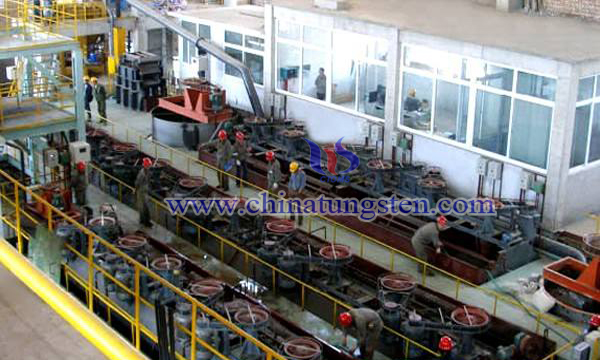A Froth Floatation Method Using Low-Tungsten Tin Concentrate to Produce APT
- Details
- Category: Tungsten Information
- Published on Thursday, 26 July 2018 18:32
In ore deposits, tungsten is more or less symbiotic with minerals such as tin, copper, antimony, bismuth or molybdenum. Tungsten ore is separated by gravity concentration method, froth flotation method, or gravity concentration-froth flotation process. However, for the associated tungsten in the complex tin concentrate, it is difficult to separate by using the conventional ore separation methods. When the tin concentrate containing ≥1%, the high melting point of tungsten will affect the smelting of tin concentrate.

Therefore, some scholars have proposed a froth floatation method using low-tungsten tin concentrate to produce ammonium paratungstate (APT). It has the following advantages: The process is simple and short; the leaching solution can be recycled; the leaching of tungsten is not affected; It is suitable for large-scale processing of low-tungsten tin concentrates.
The preparation method is briefly described as follows:
1) Prepare a solution with an initial alkali concentration of 450 g/l of sodium hydroxide, put it into a low-tungsten tin concentrate to adjust the slurry, and pump the slurry into the autoclave at 140 ° C for 2 hours, the pressure is 0.3 MPa, after the reaction is over. The final alkali concentration is ≥250 g/l, and the leaching slurry is filtered. The leaching residue contains 12.3% of WO3, washed with 5 m3 of water, the washing water contains WO3 of 5.88 g/l, and the washing water contains 9.24 g/l of alkali. In the resin adsorption step, WO3 was 0.34% in the leached slag after treatment, and the WO3 leaching rate was 91.34%.
2) Composition of tungsten-tin concentrate: WO3 6%, Sn 38%.
The first leachate was made into a solution with a sodium hydroxide alkali concentration of 560 g/l, and the slurry was poured into a low-tungsten tin concentrate. The slurry was pumped into an autoclave and stirred at 150 ° C for 2 hours at a pressure of 0.6 MPa. The final alkali concentration is ≥250 g/l, and the leaching slurry is filtered. The leaching residue contains 13.25% of WO3 and is washed with 5 m3 of water. The washing water contains WO3 of 6.32g/l and the washing water contains alkali of 10.11g/l. In the resin adsorption step, WO3 was 0.26% in the leaching residue after treatment, and the WO3 leaching rate was 90.23%.
3) Composition of tungsten-containing tin concentrate: WO3 8%, Sn42%.
The second leachate was made into a solution with a sodium hydroxide alkali concentration of 600 g/l, and the slurry was poured into a low-tungsten tin concentrate. The slurry was pumped into an autoclave and stirred at 160 ° C for 2.5 hours at a pressure of 0.8 MPa. The final alkali concentration is ≥250 g/l, and the leaching slurry is filtered. The leaching slag contains 14.3% of WO3, washed with 5 m3 of water, the washing water contains WO3 of 7.9g/l, and the washing water contains 11.2g/l of alkali. In the resin adsorption step, WO3 was 0.39% in the leaching residue after treatment, and the WO3 leaching rate was 89.56%.
After three times of washing and mixing, it directly enters the resin adsorption, desorbed with ammonium chloride and ammonia water to obtain APT leaching liquid, and the liquid is concentrated and crystallized to obtain an APT containing 89.2% of WO3.
- Tungsten Manufacturer & Supplier, Chinatungsten Online: www.chinatungsten.com
- Tungsten News & Prices of China Tungsten Industry Association: www.ctia.com.cn
- Molybdenum News & Price: news.molybdenum.com.cn
- Tel.: 86 592 5129696; Fax: 86 592 5129797; Email: sales@chinatungsten.com



 sales@chinatungsten.com
sales@chinatungsten.com